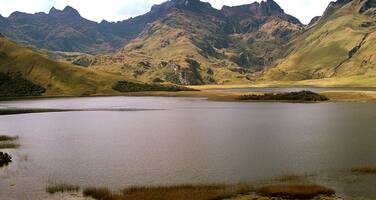Sangay National Park
Factors affecting the property in 1997*
- Ground transport infrastructure
- Identity, social cohesion, changes in local population and community
- Illegal activities
- Land conversion
- Livestock farming / grazing of domesticated animals
- Management systems/ management plan
Factors* affecting the property identified in previous reports
- heavy poaching of wildlife,
- illegal livestock grazing,
- encroachment along the Park's perimeter,
- unplanned road construction.
International Assistance: requests for the property until 1997
Total amount approved : 58,500 USD
| 1993 | Equipement for Sangay National Park (Approved) | 28,500 USD |
| 1985 | Public awareness programmes for local communities and ... (Approved) | 30,000 USD |
Missions to the property until 1997**
March 1989: IUCN
Information presented to the Bureau of the World Heritage Committee in 1997
At its last session (Merida, 1996), while commending the Park administration's (Instituto Ecuadoriano Forestal y de Areas Naturales y Vida Silvestre, (INEFAN)) actions and reports, the Committee reiterated its serious concerns about road construction activities, poaching and colonization, and its request for an Environmental Impact Assessment. The Committee requested Ecuador to provide a report by 15 April 1997, for consideration by the Bureau. No such report had been received at the time of preparation of this document.
IUCN has informed the Centre that it will provide a written report on Sangay for the Bureau meeting. A representative of Ecuador is expected to submitted a status of conservation report on Sangay at the World Heritage Workshop, to be convened during the First Latin American Parks Congress, in Santa Marta, Columbia (21-28 May, 1997).
Action Required
The Bureau, based on new information that may be available at the time of its meeting, may review the state of conservation of Sangay and make appropriate recommendations for the consideration of the Committee.
Conservation issues presented to the World Heritage Committee in 1997
At its last session (Merida, 1996), the Committee reiterated its concerns regarding road construction, poaching and colonisation and its call for Environmental Impact Assessment (EIA) of the road construction project. The Bureau, at its twenty-first ordinary session in June 1997, was informed that colonisation in the Guamboya Valley and along the River Palora, and small scale mining activities had been stopped, a new management plan was nearing finalization and that several conservation projects funded by WWF had begun. IUCN is currently studying, with WWF, the feasibility for fielding a site visit to discuss and design measures for mitigating impacts of the Guamote Macas road construction projects and other threats to the integrity of Sangay.
Summary of the interventions
Decisions adopted by the Committee in 1997
21 BUR IV.A.5
Sangay National Park (Ecuador)
The Bureau recalled that the Committee at its twentieth session, commended the Park administration's (Instituto Ecuadoriano Forestal y de Areas Naturales y Vida Silvestre, (INEFAN)) actions and reports, but reiterated its serious concerns about road construction activities, poaching and colonization, and recalled its request for an Environmental Impact Assessment (EIA). The Bureau noted that INEFAN has submitted a report to the Centre that identifies the Guamote Macas road construction to be the main problem and that colonisation in the Guamboya valley and along the River Palora, and small-scale mining activities have been stopped. The new management plan is close to finalization and government institutions and NGOs have expressed interest in participating in its implementation.
IUCN informed the Bureau that the implementation of a number of conservation projects at Sangay, including several funded by WWF and the European Union have begun.
The Bureau commended INEFAN for its report and action, but reiterated it's calls for an Environmental Impact Assessment (EIA) of the Guamote Macas road construction project. The Bureau recommended that the Committee retain the site on the List of World Heritage in Danger.
21 COM VII.B.15
SOC: Sangay National Park (Ecuador)
VII.15 Sangay National Park (Ecuador)
At its last session (Merida, 1996), the Committee reiterated its concerns regarding road construction, poaching and colonisation and its call for an Environmental Impact Assessment (EIA) of the road construction project. The Bureau, at its twenty-first session in June 1997, was informed that colonisation, and small scale mining activities had been stopped, a new management plan was nearing finalisation and that several conservation projects funded by WWF had begun.
The Committee decided to retain Sangay National Park in the List of World Heritage in Danger and urged the Centre, in collaboration with IUCN, agreement with the State Party and possible support from WWF, to plan and organise a site visit to address the problem of the Guamote Macas road construction and other threats to the integrity of the site.
The Delegate of Ecuador welcomed the decision by the Committee to field a mission to the site and stated that the construction of the road is currently paralyzed and that the impact studies still have to be completed.
The Committee may wish to adopt the following:
"The Committee decides to retain Sangay National Park in the List of World Heritage in Danger and urges the Centre, in collaboration with IUCN, agreement with the State Party and possible support from WWF, to plan and organise a site visit to address the problem of the Guamote Macas road construction and other threats to the integrity of the site."

Exports
* :
The threats indicated are listed in alphabetical order; their order does not constitute a classification according to the importance of their impact on the property.
Furthermore, they are presented irrespective of the type of threat faced by the property, i.e. with specific and proven imminent danger (“ascertained danger”) or with threats which could have deleterious effects on the property’s Outstanding Universal Value (“potential danger”).
** : All mission reports are not always available electronically.

